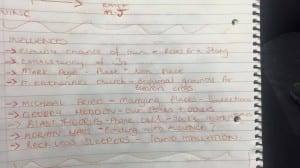After walking around my site again today (a very busy Good Friday bank holiday), I decided to make a few but small changes to my piece.
First is where in my site I will perform, all if not majority of my performance, in the centre of the space, with a chair and two tables. By doing this I am creating myself a ‘performance space/stage’ similar to ones that the Suffragettes may have created, however the way in which I interact with my space and how my audience interacts with it, will (hopefully) be the complete opposite compared to the Suffragettes movement. I intend to start by handing out to drinks to people in as my normal self, then when I come to perform my scripted lines, I will sit down on the chair in a neutral manner and perform these lines, in a manner that is not myself, I really want to detach my own personality and self from these lines as the subject is a sensitive one and a subject which effects many people. Either side of me will be two tables, one with the drinks on and one with objects on that would either ‘help prevent rape’ or is the ’cause of rape’ according to victim blaming and our rape culture, for example date rape detecting nail polish, alcohol, clothing, ect. Also on this table will be a collage of posters created by authorities groups, such as the police or government to ‘tackle rape’ but actually blame the victims. These posters will remain untouched, where as on the other table the exact same collage will be present, but I intend to deface these posters, pointing out the wrongs with them, how they victim blame instead of teaching consent, ect. I decided to deface the posters on the table with the drinks, as these ‘anti-rape posters’ fail to mention consent yet I’m allowing my audience to decide whether they have a drink or not, choosing to give consent.
I’ve also decided to wear white for this performance and as I read out certain stats, facts, figures or victim blaming phrases I’m going to deface the dress by writing on it. For any stats, facts or figures, I’m going to right the percentage on my costume in red, as red is a colour often related to something of high alert and importance, then as I read the comments made that victim blame I’m going to write over it in black, once you write on something in a black permeant marker, you fix it, which relates to the victim blaming. As the media, “anti-rape” campaigns and society focus more on how the victim could have prevented their rape, instead of the alarming facts and figures, which in turn, can be seen to be destroying any hope victims may of being heard or helped. By blaming the victim instead of acknolging the facts and stats, then society and the local authorities are missing/ignoring the real causes of rape and how to approach it. This also ties into my site as has been a place of voice, empowerement and change for both men but espeically women since the first suffragette rallie took place there over a century ago. These women fought like wise for a change and to be heard, with an equally as topical subject to mine.
I’ve decided to edit my script a bit and add in a description/information about the speakers corner, from the speakers corner Website, adding it just before the end of my piece, as the Speakers Corner is a place for raising you’re voice and my performance is raising voices about the rape culture and victim blaming.




